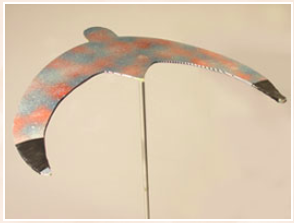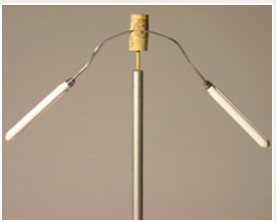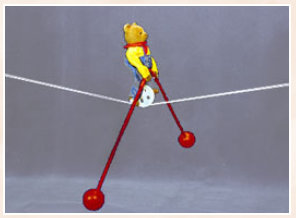Three demonstrations are available to show the center of mass of different objects.
Demo:
1. Balancing Bird: Heavy weights on its wings put the center of mass in an unlikely place – outside of the bird completely! The bird seems to float. This demo can simply be balanced on a finger.
2. Forks and cork: A simple cork, two common forks, and a toothpick provide a static demonstration of center of mass. The configuration is similar to the Bear on a String.
3. Bear on a String: A toy bear on a string balances because its center of mass is below the string. Raising and lowering one end of the string causes the bear to roll back and forth. Simple and motorized versions are available. The simple version requires students’ help to hold the string, while the motorized version mechanically moves the string to provide the bear with continuous back and forth motion.
Equipment:
- Object (Bird, Bear on a String, or Forks and Cork)
- Pivot point (rod and stand)
- String or motor + string (Bear on a String)
- Stands for the string (Bear on a String)
Explanation:
As discussed in Young and Freedman’s University Physics, there are three general things we can say about the center of mass of solid bodies with a constant density:
- If the body has a geometric center (e.g. a ball or a cube), the center of mass will be at that center.
- If the body has an axis of symmetry (e.g. a wheel or a cone), the center of mass will be on that axis.
- The center of mass can lie outside of the object (e.g. a donut).
For these demos, however, the center of mass may not be immediately obvious. Nevertheless, the bodies shown in the photos are in equilibrium – they are not accelerating or rotating. The net external force on each body must be zero, and the same goes for the net external torque around any point on the body.
With these relatively small demos, the center of gravity is identical to the center of mass. When the pivot point of the body – that is, the point at which we are balancing the body – is directly above the center of gravity, the object will be in stable equilibrium. Any small disturbance will result in a restoring torque which will bring the body back to the original equilibrium point.
For example, in the case of the bird (taking the mass of the cardboard to be negligible for the sake of argument) the gravitational force is pulling down on each wing-weight, while the normal force is pushing up on the beak. All of the external forces and torques cancel out. If we removed the left wing-weight but kept trying to balance the bird on its beak, the bird would tip over – the external forces and torques would no longer cancel. If we simply push down slightly on one of the wings, the bird will tend to “right” itself back to its equilibrium point.
Notes:
- The bird is beautifully painted, and big enough for large classes to see!


